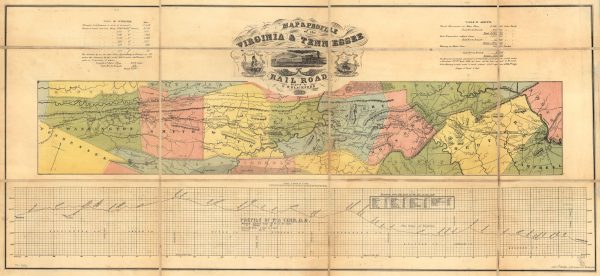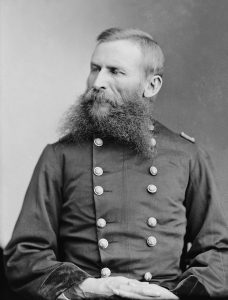Railroads – Targeted: The Virginia & Tennessee Railroad
 In early May 1864 as Union General Franz Sigel inched his way up the Shenandoah Valley and Confederate General John C. Breckinridge scrambled to assemble an army, Union cavalry commanders George Crook and William Averell aimed for Saltville and the iron tracks of the Virginia & Tennessee Railroad. It was not the first time Federals had attacked this Confederate life line in southwest Virginia, nor would it be the last. By the time Sigel and Breckinridge clashed at New Market, the cavalrymen had already turned north again, failing to permanently destroy the railroad.
In early May 1864 as Union General Franz Sigel inched his way up the Shenandoah Valley and Confederate General John C. Breckinridge scrambled to assemble an army, Union cavalry commanders George Crook and William Averell aimed for Saltville and the iron tracks of the Virginia & Tennessee Railroad. It was not the first time Federals had attacked this Confederate life line in southwest Virginia, nor would it be the last. By the time Sigel and Breckinridge clashed at New Market, the cavalrymen had already turned north again, failing to permanently destroy the railroad.
The Virginia & Tennessee Railroad had been a practical and idealized state project from the beginning. Blows at this strategic transportation system threatened both supply transportation and Virginia’s network with the rest of the Confederacy. Surprisingly, secession had been on the minds of Virginians as one of the key reasons to build the railroad over a decade earlier.
It took drama, political wrangling, sectionalism, fear of abolition, foretold secession, years of discussion, and a lot of money before the first ties, rails, and spike went into place on January 16, 1850, in Lynchburg, Virginia – two years after the original railroad charter had been passed. By 1857, the completed Virginia and Tennessee Railroad stretched from Lynchburg to Bristol. The 213 miles of track included a branch to Saltville, five tunnels, 233 bridges, and nineteen depots. However, it had cost $84,000 per mile of track, totaling to one of the most expensive railroads in the country at that time.

The Virginia & Tennessee Railroad changed the economy, society, and politics of Southwestern Virginia. Always an agriculturally rich region, the Southwest farmers now had an easier way to ship their grain or tobacco crops and livestock to eastern and northern markets since they were connected to the iron network. Production, land value, and economic profits leaped forward in the between 1850 and 1860. The citizens of the region started embracing the “modernization” brought by the railroad; culture flourished around the natural hot springs and other landmarks which became popular tourist vacationing resorts.
However, with the positive developments encouraged by the new railroad, negative ones also grew. Slavery increased in the region. In fact, the majority of the workers who built the railroad were slaves, hired out to the railroad company while their masters received the pay. With southwest Virginia linked to Richmond through a day’s travel, the slave markets and hiring-out houses offered the opportunity for profit or added “property” through the sale of humans in bondage. The region had long been a traveled route for slave traders and slave catchers moving from eastern Virginia to Tennessee and sometimes even down to New Orleans, and unfortunately, the railroad offered an easy means of transportation. The railroad company even offered “deals” to the slave traders – letting slave children be transported for free.

The political changes in southwestern Virginia were tied to the economic and social changes. Prior to the railroad’s advent, the citizens had argued and whined about eastern Virginian dominance and discussed secession of the western part of the state, joining the chorus from northwestern Virginia. Yet, the decade which saw the railroad built introduced a change. By 1860 the iron rails firmly linked Southwestern Virginia to the east and Richmond, and political leaders from the region aligned with the eastern political ideas and economic opportunity, no longer interested in regional secession. Interestingly, the Virginia & Tennessee Railroad bond the southwest region of the state to the eastern sections, making a divide from the other counties which would eventually break away to form the new state: West Virginia.
During the political debates and wranglings to get the Virginia & Tennessee Railroad built, pro-South politicians argued that the tracks would provide the needed link to Tennessee and other Southern states to the west. They envisioned a grand network that would tie the Southern states together in case of a national secession movement. Due to a variety of challenges with Southern railroad construction, that grand scheme never quite worked the way it had been vaunted in the state congress or in political opinion pieces. Still, the line through Southwest Virginia did provide a vital connection to the supplies in the region and to Tennessee beyond.
The Virginia & Tennessee Railroad company’s tracks stopped at Bristol – on the Virginia/Tennessee border. There, it joined the Tennessee project and railroad line called the East Tennessee & Virginia Railroad which ran from Bristol into Knoxville. Railroads and steamboat traffic caused Knoxville to grow exponentially during the antebellum period, making it a major transportation hub by the time of the Civil War with connections to almost every Confederate state in the lower and western region.
During the Civil War, the Virginia & Tennessee Railroad became an assert and a liability to the region. Part of key transportation and a link into Virginia’s attempt to dominate the war and control the Confederacy from Richmond, the rails also offered attack. In 1861, Union authorities had already recognized the vulnerable position of the tracks and the importance of taking Western and Southwest Virginia. Through the war years, different Union expeditions headed south, targeting the tracks and fertile region. With agriculture, mining, and industry, that region offered key supplies to Confederate armies.
The citizens’ loyalty though waned as the years dragged by. Initially favoring secession after Fort Sumter, men from Southwest Virginia rushed to enlist, but the homefront they left behind was generally less enthusiastic. Union raiders were not kind. Guerrilla bands and partisans from both sides roamed the region, sometimes battling in the towns. Dissatisfied soldiers deserted and made their way to the area, joining up with the guerrillas or simply forming thieving bands for personal gain. By 1864, most of the citizens were sick of the war which had wrecked their society, economy, and railroad.

Generals Crook and Averell had to abandon their plans to take Saltville and burn Wytheville, but they reported “the railroad was destroyed as much as practicable” before retreating when they heard rumors. Their damage to the track was repaired in just a few weeks.
However, during the autumn of 1864 fighting, skirmishing, and campaigning once again targeted the railroad, and in December, Union General George Stoneman headed in. He spent less than a week in Virginia before retreating to back to Tennessee but decisively crushed the railroad and Confederate morale in the region. Abingdon, Brisol, Saltville, Wytheville – all important towns with railroad connections – were burned, and the cavalry commander reportedly destroyed all the railroad bridges and depots on his march and put thirteen locomotives out of commission. The Virginia & Tennessee Railroad had lost its link to the region’s supplies and the rest of the south.
Confederate support had wavered and collapsed in the region soon than in other parts of Virginia. Emancipation also came sooner. The Union raids and advances toward the railroad gave slaves the chance they needed to make a run for freedom, leading to a quick collapse of slavery. The railroad had brought quick changes to the region prior to the Civil War and fostered even more changes during the conflict simply by offering a strategic location that placed civilians, a regional economy, and slaves with the military sights of the Union armies.
Following the Civil War, the Virginia & Tennesse Railroad was repaired. By 1867, former Confederate general William Mahone stepped in as president of the company, and the railroad tracks became part of his railway empire stretching through the South. The antebellum Virginians had been correct to envision their railroad reaching into a vast national network of tracks, helping to connect the southwest part of their state into the national picture and opportunities.
The Virginia & Tennessee Railroad fostered great change in its region prior, during, and after the Civil War. Due to its strategic significance and logistical advantages, the tracks were targeted by Union armies and cavalry from the beginning of the war. Caught in the cross-hairs and living beside the tracks, the citizens of Southwest Virginia had a unique war experience; for some, freedom came early, for others, the rough warfare wrecked their plans and hopes. Studying the Virginia & Tennessee Railroad offers a small glimpse into the power of railroads to change an antebellum region, bring military forces to an area, and reconstruct an opportunity and economy.
Sources:
Noe, Kenneth W. Southwest Virginia’s Railroad: Modernization and the Sectional Crisis in the Civil War Era. University of Alabama Press, 1994.
Totally off topic, but those are two crazy beards.
Perhaps we could have “Civil War Beards & the Men Who Wore Them,” as a monthly topic, followed by “Bad Hair Days.” Seriously!
Haha. That could be fun for a week or two. I’ll put it on our idea list for the future.
I’ve enjoyed reading all of the stories about trains used during the war. On April 21, 1863 one of my ancestors, a captain in the 16th GA Cavalry Battalion, wrote about coming across a train engine and its tender that had run into the Watauga River in East Tennessee. Evidently the bridge had been burned or damaged by Union troops or some of the local “bridge burners” living in that area, who had remained loyal to the US. When something like this occurred, does anyone know if the engine would somehow be removed from the water, repaired (if possible) and placed back into service (if the repairs were successful), or would it just be left where it came to rest and salvaged for parts?